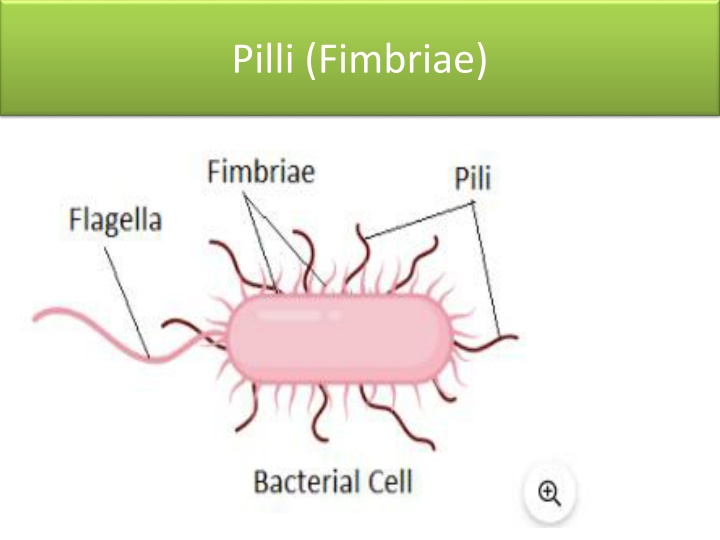Pilli (Fimbriae)
Bacterial pili, also known as fimbriae, and capsules play crucial roles in bacterial functions such as adherence, mating, and infection. Pili are hair-like structures on procaryotic cells, while capsules are viscous layers surrounding the cell wall. Pili aid in genetic transfer and pathogenic attachment, while capsules provide protection, block bacteriophages, and promote bacterial surface attachment. Understanding the functions of these structures is vital for studying bacterial behavior and virulence.
Download Presentation

Please find below an Image/Link to download the presentation.
The content on the website is provided AS IS for your information and personal use only. It may not be sold, licensed, or shared on other websites without obtaining consent from the author.If you encounter any issues during the download, it is possible that the publisher has removed the file from their server.
You are allowed to download the files provided on this website for personal or commercial use, subject to the condition that they are used lawfully. All files are the property of their respective owners.
The content on the website is provided AS IS for your information and personal use only. It may not be sold, licensed, or shared on other websites without obtaining consent from the author.
E N D
Presentation Transcript
Pilli (Fimbriae) Fimbriae and pili are interchangeable terms used to designate short, hair-like structures on the surfaces of procaryotic cells. Like flagella, they are composed of protein. Fimbriae are shorter and stiffer than flagella, and slightly smaller in diameter. Generally, fimbriae have nothing to do with bacterial movement (there are exceptions, e.g. twitching movement on Pseudomonas). Fimbriae are very common in Gram-negative bacteria, but occur in some archaea and Gram-positive bacteria as well. Fimbriae are most often involved in adherence of bacteria to surfaces, substrates and other cells or tissues in nature. In E. coli, a specialized type of pilus, the F or sex pilus, apparently stabilizes mating bacteria during the process of conjugation, but the function of the smaller, more numerous common pili is quite different.
Continu. Pilli are hollow, nonhelical, filamentous appendages that are thinner, shorter and more numerous than flagella. Several functions associated with different types of pilli. One type, known as the F pilus (or sex pilus), serves as the port of entry of genetic material during bacterial mating. Some pilli play a major role in human infection by allowing pathogenic bacteria to attach epithelial cells lining the respiratory, intestinal or genotourinary tract. This attachment prevents the washed away by the flow of mucous or body fluids and permits the infection to be established. bacteria from being
Some bacterial cell surrounded by a viscous substance forming a covering layer or envelope around the cell wall. When a gel-like layer forms a well-defined condensed layer around the bacterial envelope, it is called a capsule and is demonstrable by a light microscope. When this gel-like layer is narrower, detectable only by indirect serological methods or by electron microscope but not by light microscope, it is called a microcapsule. An amorphous viscid colloidal material secreted by some bacteria extracellularly is termed as loose or free slime or glycocalyx. Capsules appear to be amorphous gelatinous area surrounding a cell. Capsular material are not highly water-soluble and therefore does not readily diffuse away from the cells that produce it. In other instances the material is highly water soluble and dissolves in the medium. Capsule
Conti. Capsule can serve as a number of functions, depending on the bacterial species- 1. Provide protection against temporary drying by binding water molecules. 2. Block attachment of bacteriophages 3. Antiphagocytic i.e., they inhibit the engulfment of pathogenic bacteria by WBC and thus contribute to invasive or infective ability (virulence). 4. Promote attachment of bacteria to surfaces, for example, Streptococcus mutants, a bacterium associated with producing dental caries, firmly adheres to the smooth surfaces of teeth because of its secretions of a water-insoluble capsular glucans. 5. If capsules are composed of having an electrical charge, such as sugar- uronic acids, they promote the stability of bacterial suspension by preventing the cells from aggregating and settling out, because cells bearing similarly charged surface tend to repel one another.
Conti. Bacterial capsules are composed of polysaccharides. Capsules composed of single kind of sugar are termed homopolysacchrides, and are usually synthesized outside the cell from disaccharides by exocellular enzymes. Other capsules are composed of different kinds of sugars and are termed heteropolysaccharides these are usually sythesized from sugar precusors that activates within the cell, attached to a lipid carrier molecule, transported across the cytoplasmic membrane and polymerized outside the cell. A few capsules are polypeptides. For example, the capsule of the anthrax organisms, B. anthracis, is composed entirely of a polymer of glutamic acid is the rare D optical isomer rather than the usual L isomer commonly found in nature.



